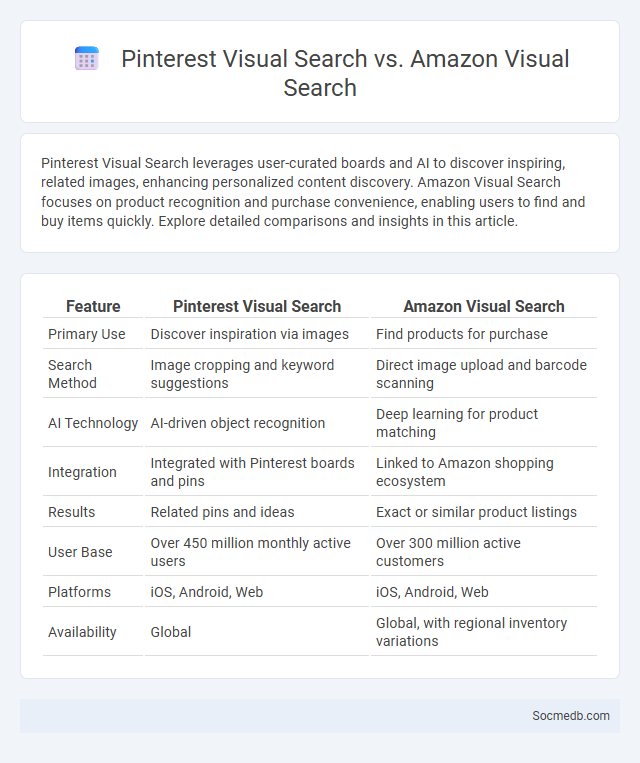
Photo illustration: Pinterest Visual Search vs Amazon Visual Search
Pinterest Visual Search leverages user-curated boards and AI to discover inspiring, related images, enhancing personalized content discovery. Amazon Visual Search focuses on product recognition and purchase convenience, enabling users to find and buy items quickly. Explore detailed comparisons and insights in this article.
Table of Comparison
| Feature | Pinterest Visual Search | Amazon Visual Search |
|---|---|---|
| Primary Use | Discover inspiration via images | Find products for purchase |
| Search Method | Image cropping and keyword suggestions | Direct image upload and barcode scanning |
| AI Technology | AI-driven object recognition | Deep learning for product matching |
| Integration | Integrated with Pinterest boards and pins | Linked to Amazon shopping ecosystem |
| Results | Related pins and ideas | Exact or similar product listings |
| User Base | Over 450 million monthly active users | Over 300 million active customers |
| Platforms | iOS, Android, Web | iOS, Android, Web |
| Availability | Global | Global, with regional inventory variations |
Introduction to Visual Search Technology
Visual search technology transforms how you interact with social media by allowing image-based queries instead of text searches, enhancing content discovery and engagement. Platforms like Pinterest and Instagram leverage advanced AI algorithms to analyze visual elements and deliver precise, relevant results. Businesses can optimize their social media strategies by integrating visual search, improving product visibility and boosting user experience.
Overview of Pinterest Visual Search
Pinterest Visual Search utilizes advanced image recognition technology to help users discover related content by analyzing visual elements within pins. This feature enhances user experience by enabling seamless exploration of products, styles, and ideas directly from images without relying solely on text searches. Businesses benefit from increased engagement and traffic as Visual Search drives higher conversion rates through highly relevant, visually-driven recommendations.
Overview of Amazon Visual Search
Amazon Visual Search leverages advanced image recognition and machine learning technologies to allow users to search for products using photos instead of text keywords. This feature enhances the shopping experience by quickly identifying items within images and providing direct links to purchase options, streamlining the discovery process on Amazon's platform. Integration with social media enables seamless sharing and inspiration, driving increased engagement and conversion rates.
Core Features Comparison
Social media platforms vary significantly in core features such as content formats, user interaction mechanisms, and algorithmic personalization. Instagram prioritizes visual content with photo and video sharing, while Twitter focuses on real-time text-based updates and trending topics. Facebook combines a broad range of features including news feeds, groups, events, and marketplace functionality, offering a comprehensive user engagement experience.
User Experience and Interface Differences
Social media platforms vary widely in user experience (UX) and interface design, impacting how you interact with content and engage with others. Platforms like Instagram prioritize visual storytelling with intuitive, image-centric layouts, while Twitter emphasizes real-time updates through concise text and a streamlined feed. Understanding these interface differences helps optimize your engagement and navigation across diverse social media environments.
Image Recognition Accuracy
Image recognition accuracy on social media platforms plays a crucial role in delivering personalized content and improving user experience. Advanced algorithms analyze visual data to identify objects, faces, and scenes with high precision, enhancing content moderation and targeted advertising. Improving your social media engagement relies on leveraging platforms that utilize cutting-edge image recognition technology to better understand and cater to your preferences.
E-commerce Integration and Shopping Capabilities
Social media platforms have revolutionized e-commerce integration by enabling seamless in-app shopping experiences, directly linking product catalogs to user feeds. Features such as Instagram Shopping and Facebook Marketplace allow businesses to showcase personalized products, streamline checkout processes, and analyze consumer behavior through advanced analytics. Enhanced shopping capabilities drive higher conversion rates by reducing friction between product discovery and purchase decisions.
Visual Search for Content Discovery
Visual search technology revolutionizes content discovery on social media by enabling users to find relevant images and videos through image inputs rather than text queries. Platforms like Pinterest and Instagram leverage AI-powered visual search algorithms to analyze visual elements, improving user engagement and personalization. Businesses optimize their social media strategies by integrating visual search, enhancing brand visibility and driving more targeted traffic through image-based interactions.
Limitations and Challenges
Social media platforms face significant challenges including data privacy concerns, misinformation spread, and algorithmic bias that can distort user perceptions. Users encounter limitations such as reduced control over personal data, exposure to echo chambers, and the risk of cyberbullying. These issues hinder trust and create obstacles for achieving safe and authentic online interactions.
Future Trends in Visual Search Technology
Visual search technology in social media is evolving rapidly with AI-driven image recognition and augmented reality integration enhancing user experience. Platforms like Instagram and Pinterest are investing in neural networks to enable more accurate object detection and contextual search results. Emerging trends indicate a shift towards real-time visual queries and personalized content discovery, driven by advances in machine learning algorithms and 5G connectivity.
 socmedb.com
socmedb.com